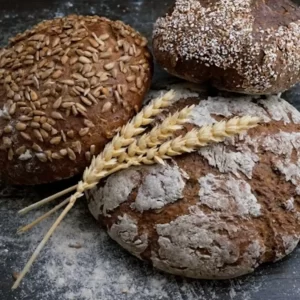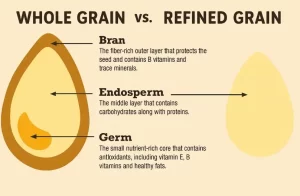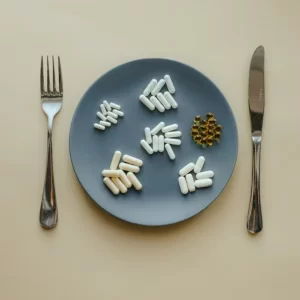
When it comes to making healthier food choices, grains and carbohydrates are often at the center of the conversation. You’ve probably heard the advice to “choose whole grains” over refined ones—but what does that really mean, and why does it matter?
What is a whole grain?
As a general rule of thumb, we want to aim for half of the grains we eat to be whole grains. Whole grains are grains that contain all parts of the grain, as they are grown in the field! There are 3 parts to a grain, and whole grains have all of them. These are:
-
Bran – the fiber-rich outer layer that also contains B vitamins, antioxidants, and trace minerals.
-
Germ – the nutrient-packed core with healthy fats, vitamin E, B vitamins, and phytochemicals.
-
Endosperm – the middle layer, mostly made up of starchy carbohydrates and small amounts of protein.
What is a refined grain?
Refined grains are processed to remove two portions of the grain: the bran and germ, leaving only the starchy endosperm. This gives the grain a finer texture and extends shelf life. Many of the common grains we enjoy are refined grains.
Refined grains are great for providing energy, but when we remove the bran and the germ, the grain looses nutritional value.
Think about it like this:
The whole grain has 3 parts to it, the bran (the fiber), the germ (the vitamins and minerals), and the endosperm (the carbs or energy)
The refined grain has 1 part to it, the endosperm (which is the carbs or the energy)
Why does this matter?
When we lose the germ and the bran, we loose fiber and vitamins and minerals. Fiber supports digestive health, helps control blood sugar, and keeps you full longer. Vitamins and minerals help support immune function, heart health, and cellular repair.
Without these components, refined grains are digested faster, and can cause spikes in blood sugar. They also leave you feeling hungry sooner than whole grains would. Diets high in whole grains are linked to lower risks of heart disease, type 2 diabetes, obesity, and certain cancers.

Examples of whole and refined grains
Common refined grains include:
-
White rice
-
White bread
-
Regular pasta
-
Many breakfast cereals
-
Pastries and baked goods made with white flour
Examples of whole grains include:
-
Brown rice
-
Quinoa
-
Oats
-
Whole wheat
-
Barley
-
Millet
Ways to make add in more whole grains
Now that we know the difference between whole grains and refined grains, how can we make the switch?
-
Choose brown rice instead of white rice.
-
Look for 100% whole wheat bread (check the label!).
- Switch white tortillas for whole grain tortillas.
-
Start your day with steel-cut oats or whole grain cereals.
-
Use whole grain pasta or alternatives like quinoa or farro.
-
Bake with whole wheat flour or experiment with oat and spelt flours.
How do I know if my food is made with whole grains or not?
Label reading is your best friend here! Nutrition labels can be complicated, so lets break this down.
Head to this Cracker Link on Amazon.
First, lets look at the front of the packaging.
The front of the package clearly says the product is made with whole grains! That’s great! However, not all packaging says it so clearly, but thankfully there is another way to check.
Click on the 3rd image of the product. It should show the full ingredient list.
Product ingredient labels display information in order of quantity. The first ingredient listed is the highest amount in the recipe, and the last ingredient makes up the lowest amount in the recipe.
The first ingredient on any grain product should be (hopefully!) some type of grain. This product lists WHOLE GRAIN WHEAT FLOUR as the first ingredient. Notice how it says its a whole grain. This is how you tell if a product is made with whole grains or not!
Thanks for learning with me today! If you found this post helpful, check out my post on supplements here.
DISCLAIMER: At the time of writing, Rachel Eileen is not currently a Registered Dietitian Nutritionist (RDN) and all information in this post is and should be considered her opinion and is not medical advice. Any injury or ill harm occurring as a result of this publication is not the responsibility of Rachel Eileen.









